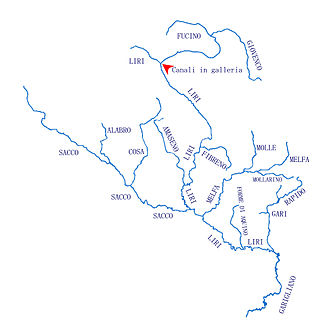Garigliano
| Garigliano | ||
|
Genesis of the Garigliano |
||
| Data | ||
| location | Italy | |
| River system | Garigliano | |
| River basin district | Appennino Meridionale | |
| source | at Sant'Apollinare , confluence of the Gari and Liri rivers 41 ° 24 ′ 35 ″ N , 13 ° 51 ′ 46 ″ E |
|
| muzzle |
Tyrrhenian Sea Coordinates: 41 ° 13 ′ 23 " N , 13 ° 45 ′ 44" E 41 ° 13 ′ 23 " N , 13 ° 45 ′ 44" E |
|
| Mouth height | 0 m | |
| Height difference | 130 m | |
| Bottom slope | 3.4 ‰ | |
| length | 38 km (158 km Liri-Garigliano) | |
| Catchment area | 5020 km² | |
| Drain |
MQ |
120 m³ / s |
| Left tributaries | Liri | |
| Right tributaries | Gari | |
|
The Garigliano at its mouth on the border between Campania and Lazio |
||
The Garigliano is a river in central Italy that flows into the Tyrrhenian Sea or the Mediterranean near the city of Minturno .
geography
The Garigliano is created by the union of the Gari and Liri rivers near Giunture, a district of Sant'Apollinare . The river has been the border between the Italian regions of Campania ( Province of Caserta ) and Latium ( Province of Latina ) since 1927 .
history
At the beginning of the 3rd century BC Chr. Who founded Rome at the mouth of the Garigliano on the Tyrrhenian Sea , the colony Minturnae , which soon developed into a major port and commercial center. Around AD 600, Minturnae was likely destroyed by the Saracens . The population withdrew to the site of the modern Minturno on a nearby hill.
In the Middle Ages, as part of the spread of Islam in Italy, Arab Muslims established an emirate at the mouth and allied themselves with the neighboring adopted duchy of Gaeta. In 915 the battle of Garigliano took place on the banks between a Christian army and the Islamic invaders.
In 1266, the Sicilian King Manfred , son of the Hohenstaufen emperor Friedrich II , was buried at the Calore Bridge in Benevento after his defeat at the Battle of Benevento . It was later dug up and buried near Sant'Ambrogio sul Garigliano in a no longer known place on the banks of the Garigliano.
In 1503 the Garigliano was fiercely contested between the French and the Spaniards, in the Second World War 1943–1944 between the Germans and the Allies at the Battle of Monte Cassino on the Gustav Line .
photos
The Ponte Real Ferdinando sul Garigliano near Minturno
literature
- Goffredo Coppola, Carmelo Colamonico, Cesare Cesari: GARIGLIANO. In: Enciclopedie on line. Istituto della Enciclopedia Italiana, Rome 1932.
- Carmelo Colamonico: LIRI. In: Enciclopedie on line. Istituto della Enciclopedia Italiana, Rome 1934.
Web links
Individual evidence
- ↑ a b Enciclopedie on line
- ^ Peter Koblank: Staufer graves. Only a few of the most prominent Hohenstaufen are buried in Germany. on stauferstelen.net. Retrieved July 8, 2014.



